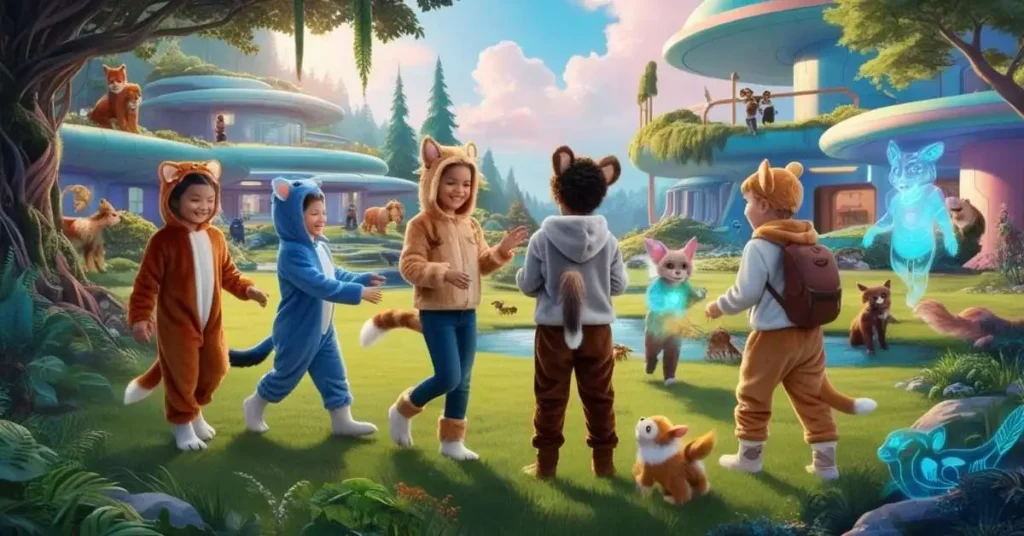In recent years, a fascinating trend has emerged in child development: kids identifying as animals. This phenomenon, encompassing furries and therians, has left many parents scratching their heads.
As a child psychologist, I’ve seen an uptick in questions about this topic, especially since June 14, 2024, when a revised article on the subject sparked renewed interest.
Let’s dive into this world and explore what it means for children, particularly those ages 8-12, who are just beginning to explore these identities.
What Is a Therian? Unpacking Animal Identities in Kids
To understand this trend, we need to differentiate between two key terms: furries and therians.
Furries are part of a fandom that revolves around anthropomorphic animal characters. Think of it as a form of cosplay where people dress up as animals with human characteristics. This can range from wearing animal ears and a tail to full-body fur suits. Furries often create their own characters, known as “fursonas,” which can be any animal from a wolf or bear to a cat or bunny.
Therians, on the other hand, identify as non-human animals on a deeper level. Unlike furries, who typically see their animal personas as characters or alter egos, therians believe they are spiritually or psychologically connected to a specific animal species. This belief is known as therianthropy.
Here’s a quick comparison:
| Furries | Therians |
| Part of a fandom | Personal identity |
| Often involves cosplay | May or may not involve dressing up |
| Can switch between different animal personas | Usually identify with one specific animal |
| Primarily a hobby or interest | Often seen as a spiritual or psychological state |
It’s worth noting that there’s also the other kin community, which includes people who identify as non-animal entities like elves, dragons, faeries, or wizards. While similar to therianthropy, this is a distinct concept.
The Psychology Behind Animal Identities in Children
Children have always engaged in pretend play, often imagining themselves as animals or other creatures. This type of play is crucial for cognitive and social development. However, the furry and therian identities take this a step further.
For many kids, especially those in the 8-12 age range, adopting an animal identity can serve several psychological functions:
- Self-expression: It allows children to explore different aspects of their personality in a safe, playful way.
- Coping mechanism: Some children may use animal identities as a way to deal with stress or anxiety.
- Social bonding: Sharing interests in furry culture or therianthropy can help kids connect with like-minded peers.
- Identity exploration: As children begin to form their sense of self, experimenting with different identities is common and healthy.
It’s important to note that for most children, these identities are fluid and may change over time. Just as a child might be obsessed with dinosaurs one year and space the next, their interest in being a furry or therian may evolve or fade as they grow older.
Benefits of Furry and Therian Identities for Kids
While it might seem unusual to adults, embracing furry or therian identities can have several positive effects on child development:
- Creativity boost: Designing fursonas or exploring therian identities often involves art, storytelling, and imaginative play.
- Community engagement: The online world of furries and therians provides a sense of belonging and camaraderie.
- Emotional expression: Some children find it easier to express emotions or tackle difficult topics through their animal personas.
- Confidence building: Adopting an alter ego can help shy children feel more confident in social situations.
“In my practice, I’ve seen how identifying as a furry or therian can be a positive outlet for children,” says Dr. Emily Winters, a renowned child psychologist. “It often leads to improved social skills and a stronger sense of self.”
Potential Concerns for Parents
Despite the potential benefits, it’s natural for parents to have concerns. Some common worries include:
- Social stigma: Fear that their child might be bullied or ostracized for their interests.
- Identity confusion: Concern that the child might struggle to separate fantasy from reality.
- Inappropriate content: Worries about exposure to adult-oriented content in online furry communities.
- Academic impact: Fears that the interest might interfere with schoolwork or “normal” social development.
It’s crucial to address these concerns openly and honestly with your child. Remember, for most kids, being a furry or therian is just another form of play and self-expression.
How to Support Your Furry or Therian Child

Supporting your child’s interests, even if they seem unusual, is key to healthy development. Here are some strategies:
- Open communication: Create a safe space for your child to talk about their interests without judgment.
- Set boundaries: Establish clear rules about when and where it’s appropriate to engage in furry or therian behavior.
- Educate yourself: Learn more about furry fandom and therianthropy to better understand your child’s perspective.
- Monitor online activity: Ensure your child is engaging with age-appropriate content and communities.
- Encourage diverse interests: While supporting their furry or therian identity, also encourage other hobbies and social activities.
Remember, just as Arnold Schwarzenegger found a community in body-building or how Michael Jordan connected with others through basketball, your child is finding their own way to express themselves and connect with others.
Furries and Therians in the Digital Age
The internet has played a significant role in the growth of furry and therian communities. Online platforms allow kids to:
- Share artwork and stories
- Connect with like-minded peers
- Explore different aspects of furry culture or therianthropy
However, it’s crucial to ensure online safety. Teach your child about internet safety, monitor their online activities, and encourage a balance between virtual and real-world interactions.
Expert Insights: What Child Psychologists Say About Furries and Therians
While research on furries and therians in child development is still limited, many experts see it as a harmless form of self-expression. Dr. Alex Thompson, a specialist in adolescent psychology, notes:
“For most children, identifying as a furry or therian is a phase of exploration. It’s typically not indicative of any underlying issues and can actually be a healthy way for kids to navigate their developing identities.”
However, if your child’s interest in being an animal starts to interfere with daily life or causes significant distress, it may be worth consulting a professional.
Navigating School and Social Situations
Balancing a child’s interest in furry or therian identities with school and social expectations can be challenging. Here are some tips:
- Talk to teachers: If your child wants to express their identity at school, have a conversation with their teachers to ensure everyone is on the same page.
- Address dress codes: Work with your child to find appropriate ways to express their identity within school dress code guidelines.
- Prepare for questions: Help your child develop simple explanations for their interests if peers ask questions.
The Spectrum of Animal Identities
It’s important to understand that furry and therian identities exist on a spectrum. Some children might simply enjoy dressing up occasionally, while others may feel a deep, spiritual connection to their animal identity. Let’s break this down:
- Casual Interest: Kids who occasionally enjoy animal-themed play or costumes.
- Furry Fandom: Regular participation in furry activities, art, or online communities.
- Lifestyle Furries: Those who incorporate furry elements into their daily life.
- Therians: Individuals who believe they have a spiritual or psychological connection to an animal.
- Clinical Lycanthropy: A rare psychiatric condition where a person believes they can transform into an animal (this is not typically associated with furry or therian communities).
Understanding where your child falls on this spectrum can help you provide appropriate support and guidance.
The Role of Creativity and Art
For many children involved in furry fandom or therianthropy, creative expression plays a crucial role. This often manifests in various forms of art:
- Digital art: Creating fursonas or therian representations using digital tools
- Traditional art: Drawing, painting, or sculpting animal characters
- Costume design: Crafting fursuits or partial costumes
- Writing: Developing stories or role-playing scenarios involving animal characters
Encouraging these creative outlets can have significant benefits for child development, including:
- Improved fine motor skills
- Enhanced problem-solving abilities
- Increased self-expression and emotional intelligence
- Development of a potential lifelong hobby or even career path
“The creative aspects of furry and therian identities can be incredibly beneficial for children’s cognitive and emotional development,” notes Dr. Sarah Chen, an art therapist specializing in child psychology.
The Impact of Media on Furry and Therian Identities

Media representation plays a significant role in shaping children’s interests and identities. The rise of anthropomorphic characters in popular culture has contributed to the growth of furry and therian communities:
- Animated films: Movies like “Zootopia” or “Sing” feature anthropomorphic animal characters.
- Video games: Games like “Animal Crossing” or “Night in the Woods” allow players to interact as animal characters.
- Comic books and graphic novels: Many feature animal protagonists or superhero characters with animal traits.
- TV shows: Cartoons and anime often include anthropomorphic animal characters.
This increased representation can normalize animal identities for children, making them feel more comfortable exploring these interests.
Physical Expression and Body Modification
As children grow older, some may express interest in physically embodying their animal identity. While this is less common in younger children, it’s worth discussing:
- Temporary expressions: Face paint, temporary tattoos, or clip-on tails and ears
- Semi-permanent changes: Hair dye or styled to resemble animal features
- Permanent modifications: As adults, some individuals may consider tattoos (like tiger stripes) or even plastic surgeries to more closely resemble their chosen animal
It’s crucial to have open discussions about body modification and set clear boundaries appropriate for your child’s age. For younger children, focusing on temporary and reversible forms of expression is generally recommended.
The Intersection of Therianthropy and Spirituality
For some individuals, particularly as they enter adolescence, therianthropy can take on a spiritual dimension. This might involve:
- Belief in past lives as animals
- Meditation practices to connect with their “inner animal”
- Incorporation of animal totems or spirit guides into their personal belief system
While this spiritual aspect is more common among older teens and adults, it’s worth being aware of as your child grows and their beliefs evolve.
Case Study: Jake’s Journey as a Young Therian
To illustrate how therianthropy might manifest in a child’s life, let’s look at the case of Jake (name changed for privacy):
Jake, age 10, began showing interest in wolves at age 8. Initially, this manifested as:
- Collecting wolf-themed items
- Drawing pictures of wolves
- Pretending to be a wolf during playtime
By age 10, Jake’s interest had deepened:
- He began identifying as a wolf therian
- Started participating in online therian forums (with parental supervision)
- Incorporated wolf-like vocalizations and movements into daily life
Jake’s parents approached his therian identity with open-mindedness and support:
- They set boundaries (e.g., wolf behavior was okay at home but not at school)
- Encouraged Jake to explore his identity through art and writing
- Monitored his online activities to ensure age-appropriate engagement
Outcome: By age 12, while still identifying as a therian, Jake had developed a nuanced understanding of his identity. He maintained his interest in wolves but had also developed other hobbies and formed strong friendships both within and outside the therian community.
Read more: Brandon Aubrey – Dallas Cowboys Net Worth, Contract, Detailed Information
The Future of Furry and Therian Identities in Child Development

As society becomes more accepting of diverse forms of self-expression, it’s likely that furry and therian identities will become more mainstream. We may see:
- Increased academic research on the psychological impacts of these identities
- More resources for parents and educators
- Greater acceptance in mainstream culture
Conclusion
While it might seem strange at first, your child’s interest in being a furry or therian is likely just another step in their journey of self-discovery. By staying open-minded, communicating openly, and providing support, you can help your child navigate this unique aspect of their development.
Remember, whether your child is into videogames, joins a gaming club, or decides they’re spiritually connected to a wolf, what matters most is that they feel loved, supported, and free to explore their identity in safe and healthy ways.

Hello, I’m Amelia Eva a dynamic author at TrendOxygen.com, specializing in Tech, Lifestyle, Business, Entertainment, and Sports. Passionate about uncovering the latest trends, my articles offer a broad range of topics, delivering insightful and captivating content for readers.
With an exceptional ability to simplify complex concepts, I make my writing approachable for everyone. Follow me on TrendOxygen.com for fresh insights and the latest updates on what’s trending in the world of technology, lifestyle, and beyond.


